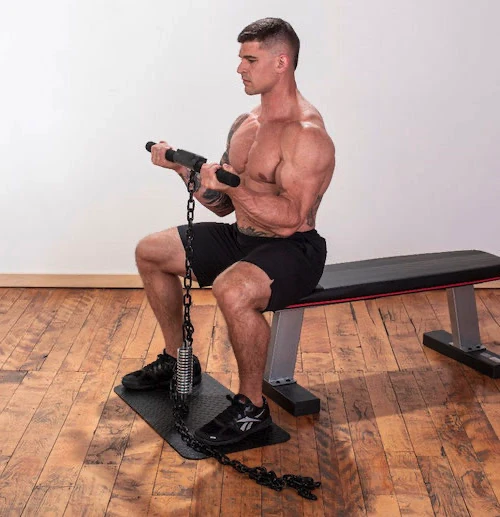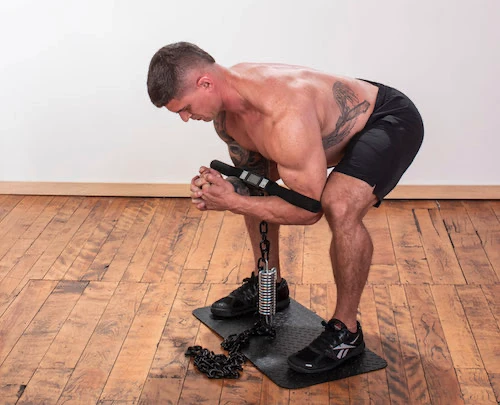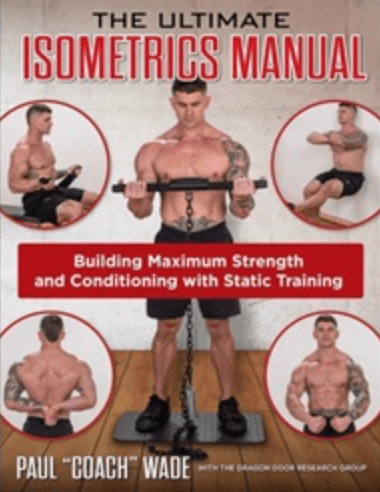The fellows from Dragon Door claim to have build a product that helps smash through the secret obstacle that limits your strength gaining ability and reach your full physical capability.
And they claim to be able to do it using the IsoChain in conjunction with Paul Wade’s isometric progressive masterplan!
But first, what is the IsoChain,
Well, it looks like this!
What’s The Concept Behind The IsoChain Work Out?
The concept behind IsoChain exercise makes a lot of sense as it uses Isometrics. Isometrics is a training discipline that’s been used for a very long period of time with good success for building up strength.

However, the results can often peter out due to limitations, such as, not having a quantifiable metric of how much force you’re putting into your workout.
If you don’t have anything to measure, then there’s nothing to compare it to, and progress more often than not diminishes.
This becomes an issue because it’s:
- Hard to track progress
- Harder to program progress like regular strength training
The solution to the problem seems simple, add a force gauge to the handle or chain to measure how much force you’re applying… and, that’s exactly what IsoChain by Dragon Door have done.
This digital reader can record the force in Kilograms that you are exerting on the bar. It displays it on a screen for you to read after applying your rep on the bar.

The figure can be recorded and be used as a datapoint to improve on. The next time you do your training session, you compare it to your old reading and slowly build up strength.
Isometric Vs Isotonic Training
Isometric training is an exercise that’s used to exert tension to the muscles and recruit them without the lengthening or shortening of the muscles.
In other words, imagine trying to lift up an immovable object. Your muscles will flex, but they will not expand or compress as you are not able to move the object.
Isometric exercises include, but not limited to:
- Plank hold
- Body hold
- Wall sit
- Forearm plank
This type of exercise is ideal for those with limited workout space and can help promote strength with limited movement in areas such as joints.
Isotonic training involves flexing your muscles and expanding or compressing them during a workout. Most exercises we can think of are isotonic, where your move your body or weights through a distance at a range of difference motions.
Isotonic exercises include, but not limited to:
- Pushups
- Dumbell curls
- Pullups
- Situps
How Does Dragon Door IsoChain Work?
It’s a metal base plate, where you hook up a chain and on the other end of the chain you attach a handle.
By standing on the metal base plate, you essential pull or push on the handle as if trying to lift your own body weight off the ground.
This is what’s called Isometric resistance, as you are creating resistance on your muscles without any joint movement.
Let’s look at some visual explanations as to how it works!
Isometric Strength Conditioning

Front Squat IsoChain Training

Seated Curl Training


Are There Any Programs To Follow?

From the examples above, we get a taster of only a few positions that can be used to work different parts of the body. So, as can be seen, the IsoChain is a fully adaptable exercising kit designed to work all parts of the body.
However, to get more advanced at it, the guys from Dragon Door have teamed up with Paul Wade who has developed specifically the Progressive Masterplan for getting superb results with Isometric training.
Why not check it out!?
Why Use The IsoChain?
This piece of equipment is as solid as steel but only weighs a few pounds. It is also very thin in profile making it extremely easy to carry with you on your travels.
There’s no need to pay expensive fees at commercial gyms. The IsoChain takes up no more than 2 square feet of space, making it easy to work out at your home, even at the most modest size homes.
Here are a few more advantages the IsoChain brings
- As solid as steel by weighs only a few pounds (easy to transport)
- Takes up less the 2sq feet (easy to workout at home)
- No need to join commercial gyms
- Digital gauge to measure strength accurately
- Audibly tell you when you hit your target
- Muller and Hettinger, 1954 studies should isometric training strengths muscle quicker than dynamic training
- Significant reduction in injury due to no movements in joints
- Quicker recovery times compared to isotonic exercise
How Much Does IsoChain Cost?
The IsoChain is priced at $499.00 or can be paid in 4 interest-free instalments of $124.75 through Paypal.
The Benefits of Isometric Strength Training
To understand the benefits of Isometric strength training, it’s important we look at studies to back the claims it has on health and performance benefits.
These exercises can be performed in the comfort of your own home and do not necessarily require hours upon hours of commitment. They might well be enough to make significant improvements to health and lifestyle, so be sure to share this list to friends and family.
Studies show isometric exercise lowers both systolic blood pressure & diastolic blood pressure and arterial pressure. The data suggests this form of training has great potential of reducing overall blood pressure and is a good alternative way of exercising.
Mayo Clinic Proceedings – 2014
Reduction in pain and enhanced vitality was achieved with Isometric stabilisation exercise among women with chronic low back pain. The effects lasted for at least 9 months.
Human Kinetics Journal – 2012
Isometric exercise is able to offer immediate relief from nicotine craving. Or to be more precise, remove the desire to smoke.
Human Psychopharmacology – 2006
Combining isometric strength training with endurance training has shown to have beneficial effects on performance during the endurance events.
European Journal of Applied Physiology – 2012
Final Thoughts
As someone in my 40s and having neglected my body somewhat with lack of exercise and unhealthy eating, I decided to do something about it.
The exercise of choice is long distance running and cycling were I would cover anywhere between 4 – 12 km and 12 – 18km respectively.
This has greatly improved my energy levels and I feel much better. However, I often wonder the impact it may have on joints and tendons (especially with running) in future years?
Isometric training is certainly not one that I ever thought of, but it’s potential is great enough for me to add it into my exercise regime!
